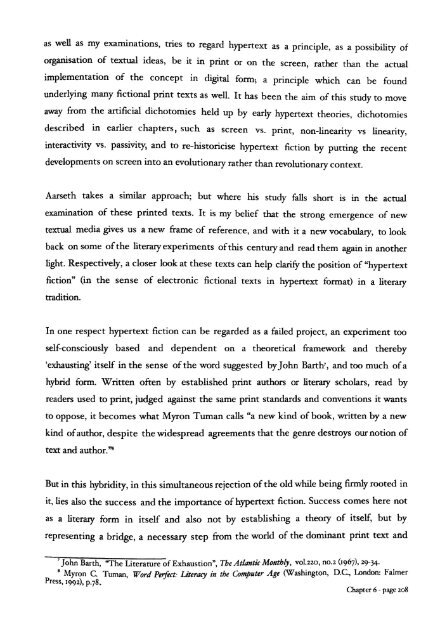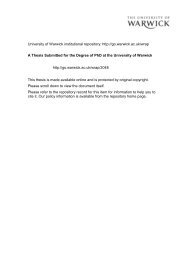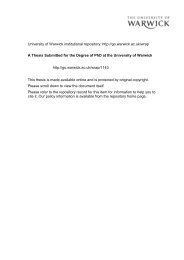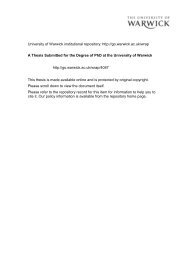From Page to Screen - WRAP: Warwick Research Archive Portal ...
From Page to Screen - WRAP: Warwick Research Archive Portal ...
From Page to Screen - WRAP: Warwick Research Archive Portal ...
You also want an ePaper? Increase the reach of your titles
YUMPU automatically turns print PDFs into web optimized ePapers that Google loves.
as well as my examinations, tries <strong>to</strong> regard hypertext as a principle, as a possibility of<br />
organisation of textual ideas, be it in print or on the screen, rather than the actual<br />
implementation of the concept in digital form; a principle which can be found<br />
underlying many fictional print texts as well. It has been the aim of this study <strong>to</strong> move<br />
away from the artificial dicho<strong>to</strong>mies held up by early hypertext theories, dicho<strong>to</strong>mies<br />
described in earlier chapters, such as screen vs. print, non-linearity vs linearity,<br />
interactivity vs. passivity, and <strong>to</strong> re-his<strong>to</strong>ricise hypertext fiction by putting the recent<br />
developments on screen in<strong>to</strong> an evolutionary rather than revolutionary context.<br />
Aarseth takes a similar approach; but where his study falls short is in the actual<br />
examination of these printed texts. It is my belief that the strong emergence of new<br />
textual media gives us a new frame of reference, and with it a new vocabulary, <strong>to</strong> look<br />
back on some ofthe literary experiments ofthis century and read them again in another<br />
light. Respectively, a closer look at these texts can help clarify the position of "hypertext<br />
fiction" (in the sense of electronic fictional texts in hypertext format) in a literary<br />
tradition.<br />
In one respect hypertext fiction can be regarded as a failed project, an experiment <strong>to</strong>o<br />
self-consciously based and dependent on a theoretical framework and thereby<br />
'exhausting' itself in the sense ofthe word suggested by]ohn Barth', and <strong>to</strong>o much ofa<br />
hybrid form. Written often by established print authors or literary scholars, read by<br />
readers used <strong>to</strong> print, judged against the same print standards and conventions it wants<br />
<strong>to</strong> oppose, it becomes what Myron Tuman calls "a new kind of book, written by a new<br />
kind ofauthor, despite the widespread agreements that the genre destroys our notion of<br />
text and author."<br />
But in this hybridity, in this simultaneous rejection ofthe old while being firmly rooted in<br />
it, lies also the success and the importance ofhypertext fiction. Success comes here not<br />
as a literary form in itself and also not by establishing a theory of itself, but by<br />
representing a bridge, a necessary step from the world of the dominant print text and<br />
7 John Barth, "The Literature of Exhaustion", The AtlanticMonthly, VOLz20, nO.2 (1967), 29-34·<br />
8 Myron C. Tuman, Word Perfect: Literacy in the Computer Age (Washing<strong>to</strong>n, D.C., London: Falmer<br />
Press, 1992), P.78•<br />
Chapter 6 - page 208





